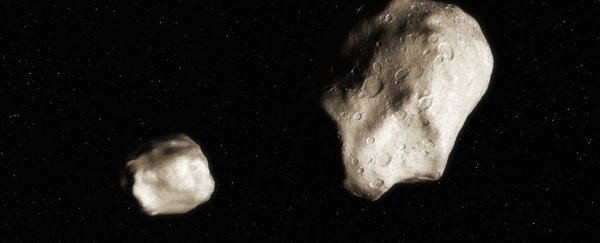
Astronomers Spot The Youngest Pair of Asteroids Ever Discovered in The Solar System
MICHELLE STARR 7 FEBRUARY 2022A pair of asteroids orbiting the Sun formed less than 300 years ago, a new study has revealed.
This makes them the youngest pair of asteroids ever discovered in the Solar System, by a factor of 10. The discovery could tell us more about how asteroids crumble, while raising some intriguing new questions.
"It's very exciting to find such a young asteroid pair that was formed only about 300 years ago, which was like this morning – not even yesterday – in astronomical timescales," says astronomer Petr Fatka of the Astronomical Institute of the Czech Academy of Sciences in Czechia.
When the Solar System formed out of a dense clump in a giant cloud of gas and dust, whatever didn't get incorporated into planets or the Sun ended up simply floating around as debris: comets, asteroids, all that crunchy stuff.
It's thought that these bodies have been drifting around since just before the dawn of our world. In fact, astronomers think that rocky planets like Earth, Venus, Mars and Mercury grew from accumulating clumps of such bodies. That makes asteroids scientifically interesting objects; not only do they contain information about the composition of the early Solar System, they might be the building blocks from which our very world formed.
We're also interested in how they change over time, since that information can help us to interpret the asteroids we do study. And it can aid the prediction of future asteroid behavior, which is pretty important for a fragile world whose entire structure of ecosystems can be obliterated by a collision with a space rock.
The two new asteroids – called 2019 PR2 and 2019 QR6 – were discovered separately in 2019, by teams of scientists using the Pan-STARRS1 survey telescope in Hawaii and the Catalina Sky Survey in Arizona respectively.
It wasn't long before the two stood out; they had an elliptical orbit that was unusual compared to other asteroids that fly close to Earth on their path around the Sun.
Binary asteroids are not unheard of. But the mechanisms of binary asteroid formation are not well understood, so scientists conducted follow-up observations to try to learn more. They used several different telescopes to take images of the pair, and studied the faintly reflected sunlight bouncing off their surfaces.
These observations revealed that the larger of the two objects is about a kilometer (0.62 miles) across, and the other about half that size. Observations from the Lowell Observatory also revealed that the two rocks have very similar surface features, suggesting that, compositionally, they are also very similar.
"It is clear that 2019 PR2 and 2019 QR6 come from the same parent object and their high orbital similarity is not coincidental," Fatka said.
To trace the origin of the objects, the researchers combined observations with modelling. These revealed that the pair separated from a larger parent body just 270 years ago.
The majority of asteroid pairs are probably the result of rotational fission. This is when a loosely bound asteroid spins so fast that it starts to break apart. The debris that crumbles away from the parent body then forms a smaller object.
This is where the questions start. With no other intervention, there are properties of the configuration of 2019 PR2 and 2019 QR6 that would have taken longer to emerge than 270 years. The team tried modeling the object again, and found that this discrepancy could be resolved if the parent body was a comet, whose outgassing could push the two asteroids into position.
That also raises questions, though.
"In the present day, the bodies don't display any signs of cometary activity," explained astronomer Nicholas Moskovitz of Lowell Observatory. "So it remains a mystery how these objects could have gone from a single parent body, to individually active objects, to the inactive pair we see today in just 300 years."
The next close approach of 2019 PR2 and 2019 QR6 will take place in 2033. So we'll just have to contain our curiosity and hope future observations will reveal more answers.
The research has been published in the Monthly Notices of the Royal Astronomical Society.




comment 0 Comments
more_vert